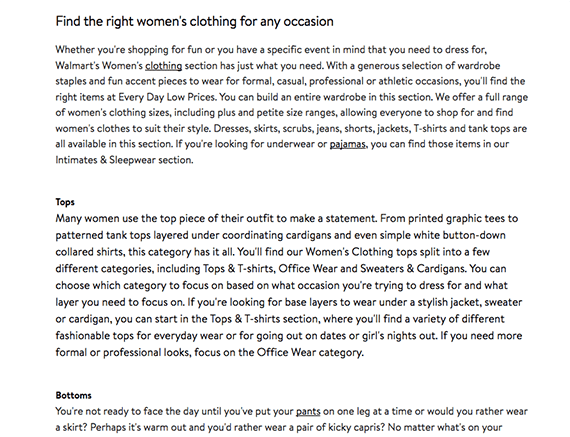Adding on-site text for search engines and not users could confuse algorithms and may amount to keyword stuffing, according to a Google spokesman.
We have all seen it: an ecommerce category page with extensive text near the footer. This copy is displayed in a tiny font and meant to add unique content for search bots, not humans.
The practice is understandable. Merchants seek to attract traffic from organic search. They know that search algorithms love unique content.
Prominent examples include a 954-word article at the bottom of the women’s clothing category page on Walmart.com, a 1,123-word post on the men’s clothing category page at Lands’ End, and 288 words about home appliances at the bottom of a Sears’ appliance category page.

Walmart.com uses extra text at the bottom of its category pages. Given the size, the text is presumably for Googlebot — not humans.
Helpful to SEO?
Clearly, the marketers at a few billion-dollar retailers believe this below-the-fold copy is helping. But John Mueller, the respected webmaster trends analyst with Google, expressed concerns about the practice during a hangout on July 23, 2019.
It’s important to understand the context. Mueller hosts question-and-answer style hangouts with interested SEO practitioners, marketers, and business owners. He offers his perspective and tries to guide his questioners toward effective SEO practices. In this case, he was not making sweeping pronouncements, but rather trying to answer a specific question.
Google’s John Mueller hosts helpful webmaster hangouts on Google. These Q&A sessions include much SEO wisdom.
About 29 minutes into the hangout, Mueller reads the aforementioned question, “Is adding a long piece of text below the actual short content — even if users ignore it — something that currently could help a site to rank better?”
Adding this sort of extra copy “is really common, for example, on ecommerce sites on category pages,” Mueller said. “From our point of view, that’s something that generally doesn’t work that well because it confuses us fairly easily.”
“On the one hand,” Mueller continued, “you’re bringing all of this ecommerce content…and then you’re adding this essentially Wikipedia article full of informational content on the bottom, and the goals of those pieces of content [are] very different. And that makes it, kind of, tricky for us to understand what this page is actually about.”
“Is this something we should show for people who are interested in buying something?” Mueller asked. “Or is this a page we should show to people who are interested in researching a topic? What is, kind of, the goal of this page?”
Mueller later suggested that adding extra text to a page just for SEO often comes close to black hat tactics.
“The other problem with adding a giant blob of text is that frequently it goes into the direction of keyword stuffing. So even in situations where we’re not completely confused as to the intent of the page, we quickly run into the situation that ‘oh, this keyword is mentioned two, three, four hundred times on this page. Maybe we should be careful on how we rank this page for that keyword.’”
Good Category Content
Mueller repeatedly encouraged site owners and managers to offer good, quality category content (for humans) rather than adding something to the end of the page (for search bots). But could Mueller’s comments and the examples from Walmart, Lands’ End, and Sears be reconciled with different page presentation and layout?
Consider the content on the Lands’ End men’s clothing category page. The copy itself is an article about how to choose “the perfect men’s outfit.” While the article does tend to use keywords such as “polo” and “men’s polo” often, it is not bad shopping advice.
Major retailers are inserting copy to help with shopping. But the presentation indicates that it is intended for search engines and not people.
Instead of displaying this copy in tiny, 10-pixel font, could it be better integrated with the product content? Perhaps the copy could be moved up the page for a guided selling experience or even to filter products based on how shoppers answered fashion questions?
Thus ecommerce marketers have a dilemma. Too little content on the page, and Google won’t value it or rank it. Too much content, as Mueller points out, muddles the page’s intent. The solution may be in finding more creative ways to integrate copy and prose with the products displayed on a category page. It will likely require testing and measuring organic search traffic.